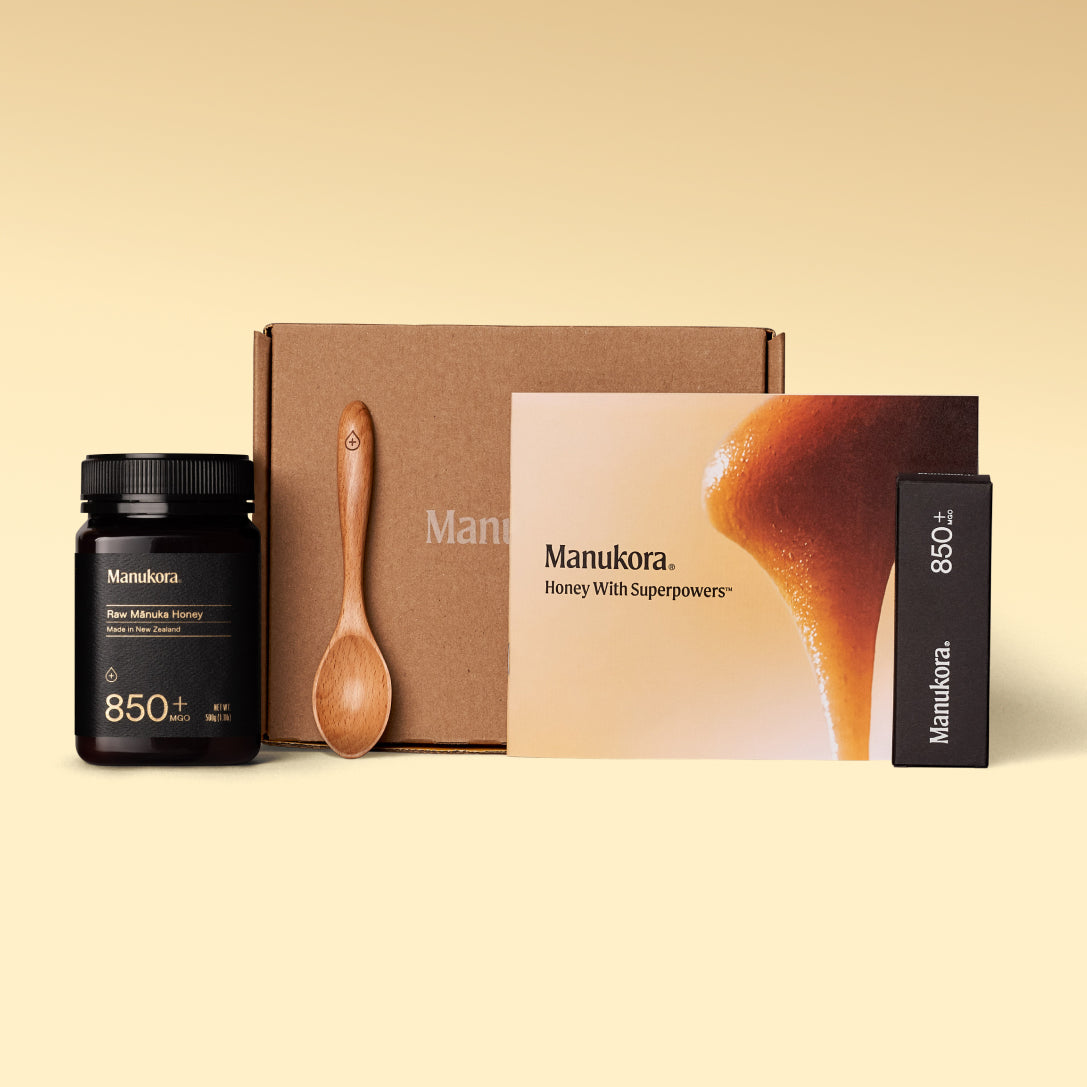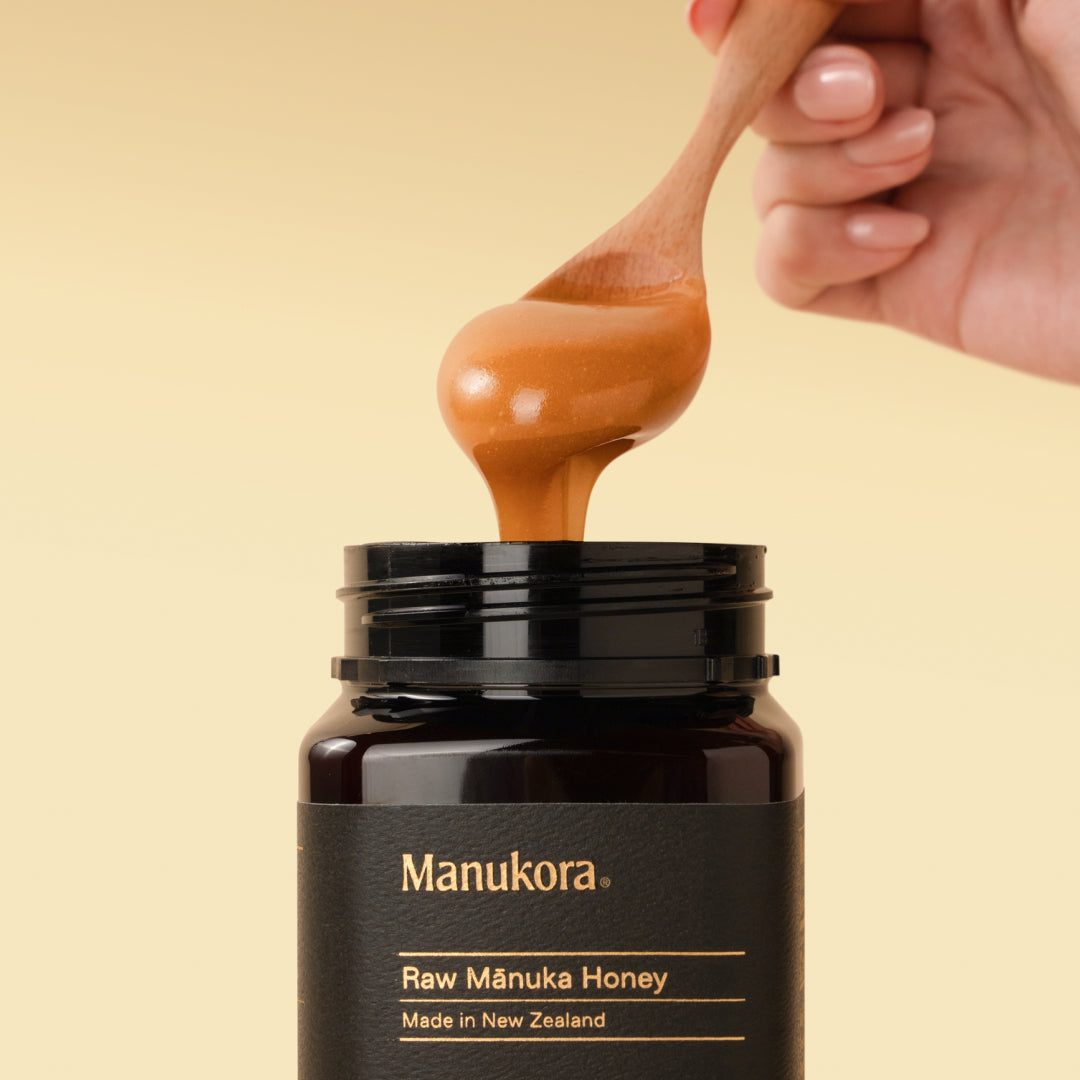Executive Summary:
-
MGO (methylglyoxal) is a naturally occurring compound that forms in Manuka honey from DHA, found in the nectar of the Manuka tea tree.
-
The formation of MGO is a gradual, natural process, beginning with nectar collection and continuing through enzymatic activity in the hive and proper honey maturation.
-
MGO levels vary based on factors like hive placement, floral purity, and seasonal conditions, which is why trusted brands like Manukora test and label every batch.
-
Manukora’s traceable honey ensures transparency and quality, letting customers scan a QR code to see MGO content, lab results, and beekeeper info so they know exactly what’s in every jar.
Unveiling MGO Formation in Manuka Honey: A Natural Process
Manuka honey is known for more than its rich, creamy texture and deep golden color, it’s admired for the unique compounds that set it apart. Among those is MGO, short for methylglyoxal, a naturally occurring nutrient found in high levels only in Manuka honey.
Unlike regular honey, Manuka contains significantly more MGO, which supports a healthy microbial balance and contributes to the honey’s distinctive properties. But how does MGO get there?
In this post, we’ll explore the natural process behind MGO formation starting from the nectar of the Manuka tea tree all the way to the spoonful of honey in your kitchen. Understanding this journey helps reveal what makes Manuka honey so rare and so special.
Nectar Collection: The First Step
The journey to Manuka honey begins in the remote, rugged landscapes of New Zealand, where the native Manuka tea tree (Leptospermum scoparium) blooms for only a few weeks each year. During this short window, honeybees collect nectar from the Manuka flowers setting the stage for a truly unique honey.
Hive placement plays a critical role in the quality of the final product. Beekeepers carefully position hives in areas rich with Manuka blossoms, minimizing the bees’ exposure to other floral sources. This ensures the honey remains as pure and consistent as possible.
Once the hives are in place, the bees get to work gathering nectar using their proboscis, a thin, straw-like tongue designed for delicate extraction. They store the nectar in a specialized part of their body called the proventriculus, a temporary holding chamber that keeps it safe during flight.
Back at the hive, the nectar is transferred to house bees, who begin the slow and natural process of turning that nectar into honey.
It all begins with a bloom. For Manuka honey, the first step to MGO starts deep in the wild landscapes of New Zealand.
The Biochemical Transformation in the Hive
Once nectar reaches the hive, the real transformation begins. House bees carefully pass the nectar from one to another, a process that naturally reduces moisture levels and begins breaking down the nectar’s complex sugars.
To complete the drying process, bees deposit the thickening liquid into honeycomb cells and fan it with their wings. This airflow helps lower the moisture content to below 20%, creating an environment where bacteria can’t thrive and the nectar officially becomes honey.
Throughout this stage, natural enzymes are hard at work. One enzyme, invertase, breaks down the nectar’s sucrose into simpler sugars like glucose and fructose. At the same time, other enzymes gradually increase the honey’s acidity helping maintain its long shelf life and naturally balanced state.
But what makes Manuka honey different lies in one specific compound: dihydroxyacetone (DHA). Found only in the nectar of the Manuka tea tree, DHA is the precursor to methylglyoxal (MGO). While the honey matures in storage, DHA begins to convert into MGO marking the start of what makes Manuka honey so unique.
From enzyme activity to evaporation, the hive is where nature’s chemistry turns nectar into one of the world’s most remarkable honeys.
Understanding MGO (Methylglyoxal)
Methylglyoxal, or MGO, is one of the key compounds that sets Manuka honey apart. Naturally formed from DHA during honey’s maturation process, MGO is found in significantly higher concentrations in Manuka honey than in other types of honey.
The final MGO level depends on two factors: how much DHA was present in the original nectar, and the enzymatic conditions during honey production and storage. Over time, DHA gradually converts into MGO giving the honey its strength and contributing to its unique profile.
At Manukora, MGO is used as the primary grading system to help consumers understand the honey’s concentration. Higher MGO numbers indicate a stronger level of this naturally occurring compound.
MGO supports a healthy microbial environment and is part of the reason many people include Manuka honey as part of their daily wellness routine.
MGO is what makes Manuka honey truly stand out. Formed naturally over time, MGO reflects the purity of the nectar, the work of the bees, and the care behind every jar of Manuka honey.
Factors Influencing MGO Levels in Honey
Manuka honey is known for its high levels of MGO but not every jar contains the same amount. Several natural and environmental factors influence how much MGO develops during honey production.
One key factor is hive placement. When bees have access to large, dense areas of blooming Manuka tea trees, the nectar they collect contains more dihydroxyacetone (DHA), the compound that eventually converts into MGO. In contrast, if bees collect nectar from a mix of Manuka and other native plants, the resulting honey may have a lower MGO concentration.
Seasonal conditions also matter. Weather patterns, rainfall, and temperature during the flowering season can impact how much nectar the trees produce and how much DHA is present in each bloom.
Even the Manuka variety and region influence the outcome. Different landscapes across New Zealand can yield slightly different results adding another layer of uniqueness to each batch.
That’s why trusted producers like Manukora test every batch and clearly label the MGO content so you always know exactly what you're getting.
From the trees to the temperature, nature decides the strength. MGO levels in Manuka honey are shaped by place, season, and care.
Manukora’s Approach to Maximizing MGO
At Manukora, producing high-quality Manuka honey starts with respecting the land, the bees, and the process. Our approach combines traditional methods with thoughtful innovation to help ensure naturally high MGO levels without disrupting the bees or their environment.
It begins with careful hive placement in remote regions of New Zealand, where Manuka tea trees grow wild and in abundance. This ensures bees have access to nectar rich in DHA, the compound that naturally converts into MGO during honey maturation.
We harvest with intention, always leaving enough honey behind to sustain the hive. By minimizing interference and working in harmony with seasonal rhythms, we allow the honey to develop at its own pace preserving its nutrients, flavor, and texture.
And because transparency matters, every jar of Manukora honey comes with a unique QR code. Scan it to see the MGO grade, lab results, and even meet the beekeeper behind your batch so you always know where your honey came from and what’s inside.
From the forest to the jar, Manukora’s process is guided by nature, backed by science, and built on trust.
MGO is the Superhero Nutrient in Manuka Honey
MGO is what makes Manuka honey truly unique. Formed naturally from the nectar of the Manuka tea tree, this powerful compound is the key to the honey’s exceptional profile and the reason it continues to stand out among all other varieties.
At Manukora, we don’t add MGO, we let nature create it. Through ethical beekeeping, thoughtful harvesting, and complete transparency, we ensure each jar reflects the highest standards of purity and care.
Whether you enjoy it straight from the spoon or stirred gently into a warm cup of tea, Manuka honey offers a simple way to add something meaningful to your daily routine.
Ready to experience Honey With Superpowers™?
Explore our traceable MGO 600+, 850+, and 1000+ collections today.
FAQs
What does MGO mean on a Manuka honey label?
MGO stands for methylglyoxal, a naturally occurring compound that develops in Manuka honey during maturation. The number on the label (e.g., MGO 600+, 850+, 1000+) indicates the concentration in milligrams per kilogram of honey and reflects the honey’s strength and activity.
Is a higher MGO number always better?
Not necessarily—it depends on how you plan to use the honey. Higher MGO levels reflect a stronger concentration of the compound and may be preferred for more targeted wellness routines, while lower levels are ideal for daily enjoyment and general support.
Can MGO levels increase over time?
Yes. MGO forms gradually as DHA in the nectar converts during storage. This means raw Manuka honey that is stored properly may naturally increase in MGO concentration over time, which is why accurate batch testing and labeling are important.
How does Manukora ensure consistent MGO quality?
Manukora tests every batch of honey for MGO and other key markers through certified third-party labs. Each jar is traceable via QR code, giving consumers access to lab results, harvest details, and even the beekeeper who cared for the hive.
Does raw Manuka honey always contain MGO?
Only if the honey is collected from Manuka tea tree nectar and left unprocessed. Not all honey labeled as “Manuka” is equal—authentic Manuka honey, like Manukora’s, contains naturally occurring DHA that converts to MGO as part of its natural development.
Sources:
Antibacterial activity of Manuka honey and its components
Health Benefits of Manuka Honey as an Essential Constituent for Tissue Regeneration


















